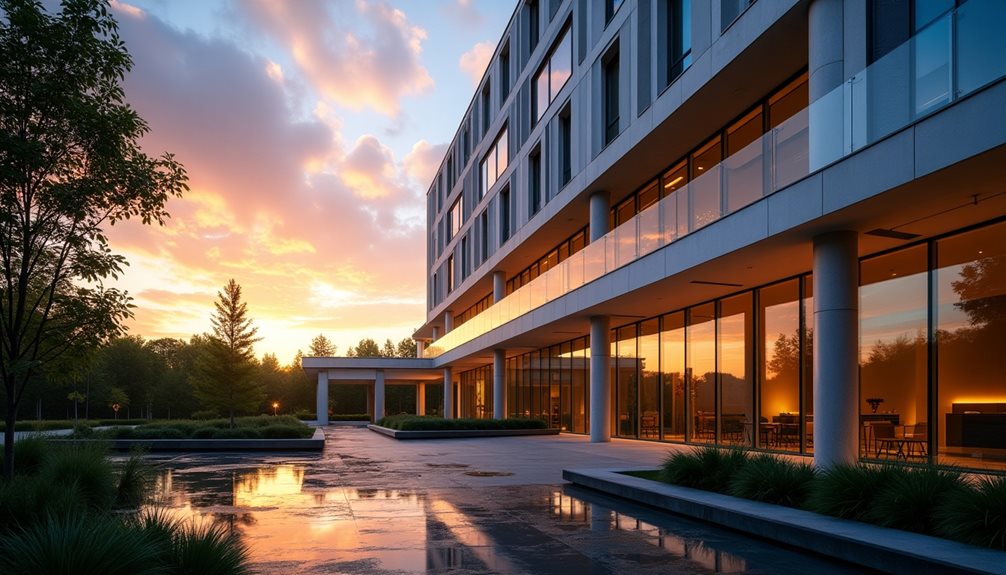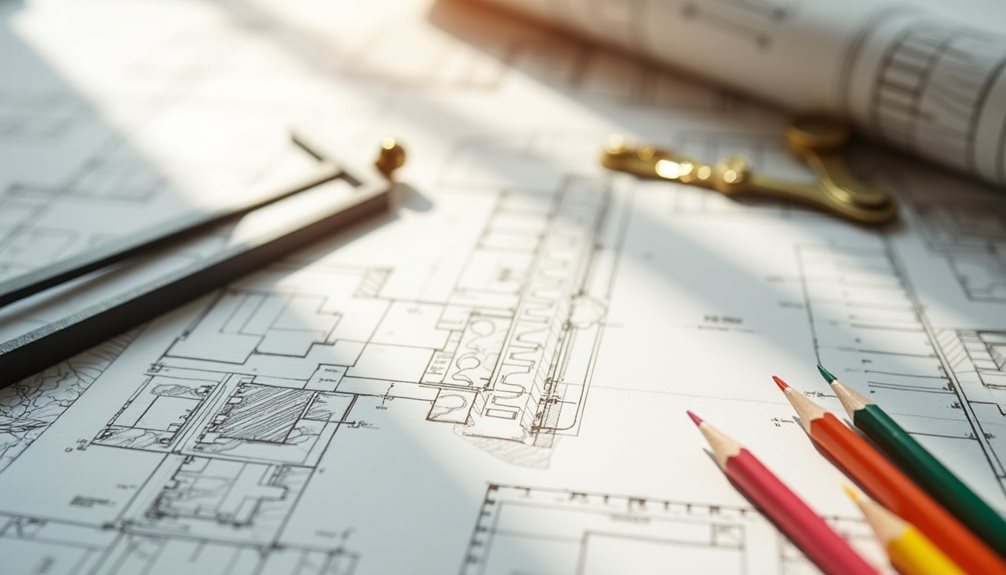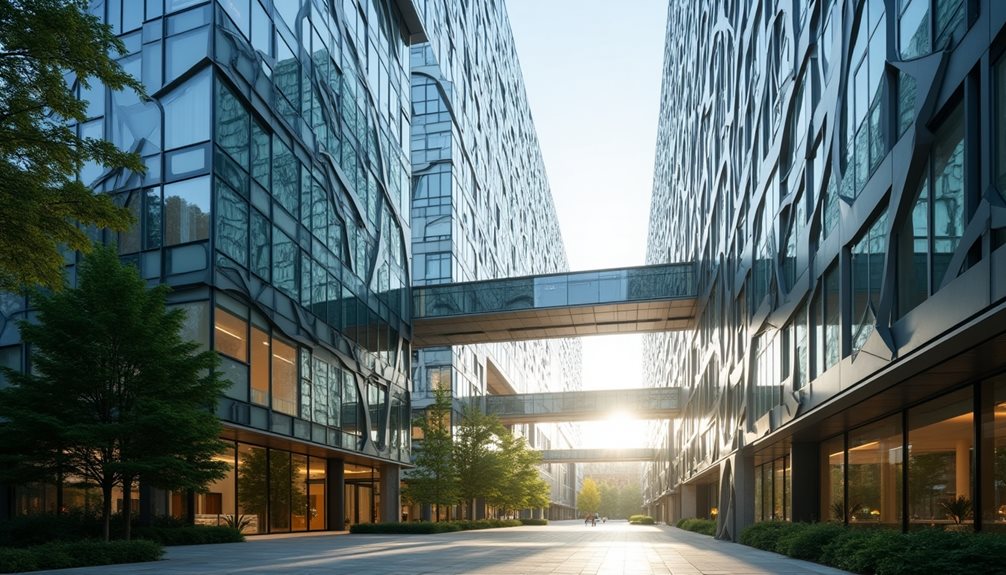Table of Contents
ToggleKey Architectural Terms in Russian

In the domain of architecture, understanding the essential terminology is crucial for effective communication and collaboration among professionals. Key architectural terms in the Russian language serve as a bridge for architects working in diverse environments.
Familiarity with terms such as “архитектор” (architect), “план” (plan), and “фасад” (facade) empowers professionals to articulate their visions clearly. Mastering this architectural terminology enriches design discussions and enhances project outcomes.
Moreover, fluency in Russian architectural terms fosters inclusivity in teams, allowing for a seamless exchange of ideas. As global architecture continues to evolve, embracing such linguistic nuances not only elevates individual practice but also cultivates a broader understanding of the discipline.
When learning Russian for architecture, knowing the right vocabulary is very important. It helps you communicate clearly with Russian-speaking architects, clients, and builders. Below, are some key Russian architectural terms, as well as their pronunciation in English phonetics.
Important Russian Architectural Words and Their Meanings
| Russian (Cyrillic) | Pronunciation (Phonetic) | English Meaning |
|---|---|---|
| архитектор | ar-khee-TEK-tor | architect |
| план | plan | plan (blueprint, layout) |
| фасад | fa-SAD | facade (building front) |
| здание | ZDAN-ye | building |
| конструкция | kon-stru-KTSI-ya | construction, structure |
| фундамент | foon-da-MENT | foundation |
| крыша | KRY-sha | roof |
| стена | ste-NA | wall |
| окно | ok-NO | window |
| дверь | dver | door |
| интерьер | in-te-RYER | interior |
| экстерьер | eks-TYE-ryer | exterior |
| колонна | ko-LON-na | column |
| арка | AR-ka | arch |
| этаж | e-TAZH | floor (level of building) |
| дизайн | di-ZAIN | design |
Explanation and Examples
- Архитектор (ar-khee-TEK-tor): This is the word for “architect,” the professional who designs buildings.
- План (plan): Just like in English, this means the drawing or blueprint that shows the layout of a building.
- Фасад (fa-SAD): This refers to the front or face of a building, often the part you see from the street.
- Здание (ZDAN-ye): Means any kind of building.
- Конструкция (kon-stru-KTSI-ya): This word means the structure or framework of a building.
- Фундамент (foond-a-MENT): The foundation or base on which a building stands.
- Крыша (KRY-sha): The roof of a building.
- Стена (ste-NA): A wall.
- Окно (ok-NO): A window.
- Дверь (dver): A door.
- Интерьер (in-te-RYER): The inside design or decoration of a building.
- Экстерьер (eks-TYE-ryer): The outside appearance of a building.
- Колонна (ko-LON-na): A vertical pillar supporting part of a building.
- Арка (AR-ka): An arch shape often used in doorways or windows.
- Этаж (e-TAZH): A floor or level in a multi-story building.
- Дизайн (di-ZAIN): The design or artistic plan of a building.
Why Learn These Terms?
Knowing these words helps you talk about architectural projects clearly. For example, if you want to describe a building’s design, you might say:
- “Фасад этого здания очень красивый.”
(Fa-SAD et-a-va zdAN-iya ochen kras-i-VYY)
— “The facade of this building is very beautiful.”
Or if you want to discuss the floor plan:
- “План этажа показывает расположение комнат.”
(Plan e-TAZha po-KA-zy-vayet ra-spa-lo-ZHE-niye kom-NAT)
— “The floor plan shows the arrangement of rooms.”
Learning key architectural terms in Russian is a great step toward working successfully in international architecture or simply understanding Russian architectural texts and conversations. This vocabulary will also help improve your overall Russian language skills by focusing on specialized words that are useful in real-world situations.
Essential Design Vocabulary for Architects
A strong design vocabulary is crucial for architects who want to communicate their ideas clearly and work well with other professionals in multidisciplinary teams. Knowing and using key design terms helps architects explain complex concepts in ways that clients, engineers, contractors, and other collaborators can understand.
Core Design Principles
Architects rely on fundamental principles such as proportion (пропорция), scale (масштаб), and harmony (гармония) to create buildings that are both beautiful and functional.
- Proportion (пропорция): This refers to the relationship between different elements of a building or space in terms of size and quantity. Proper proportions ensure that parts of a design relate well to each other, creating balance and visual appeal.
- Scale (масштаб): Scale deals with the size of objects in relation to human dimensions or other elements within a space. Architects must consider scale to ensure their designs feel comfortable and appropriate for users.
- Harmony (гармония): Harmony is about achieving a pleasing and consistent arrangement of parts in a design, where colors, shapes, materials, and textures work together without conflict.
Spatial Organization and Its Impact
Understanding how space is organized is fundamental for architects to design environments that function smoothly and enhance how people interact with them. This includes:
- Layouts (планировка): The arrangement of rooms, areas, and facilities within a building or site. Good layouts consider accessibility, privacy, and functionality.
- Circulation Patterns (схема перемещения): These describe how people move through spaces, including pathways, corridors, stairways, and entrances. Effective circulation design prevents congestion and ensures safety.
- Zoning (зонирование): The division of space into different areas based on their use, such as public versus private zones or work versus leisure areas. Proper zoning improves usability and comfort.
Additional Important Terms
- Balance (баланс): The visual equilibrium of a design, achieved by distributing elements evenly or asymmetrically.
- Rhythm (ритм): The repetition or patterning of elements that guide the viewer’s eye through a space.
- Contrast (контраст): The use of opposing elements like light and dark, rough and smooth textures, or large and small shapes to create interest.
- Texture (текстура): The surface quality of materials used in a design, which affects how a space feels both visually and physically.
- Light (свет): Natural and artificial lighting play a key role in shaping mood, highlighting features, and affecting spatial perception.
Why Mastering Design Vocabulary Matters
For architects, mastering this vocabulary is not just about technical accuracy but also about storytelling. It helps them:
- Communicate ideas clearly to clients who may not have technical backgrounds.
- Collaborate effectively with engineers, interior designers, landscape architects, and builders.
- Write precise project documents and presentations.
- Participate meaningfully in design critiques and planning meetings.
By integrating these terms into everyday practice, architects empower themselves to create well-thought-out environments that meet aesthetic goals while addressing practical needs. Understanding both the English terms and their Russian equivalents can be particularly useful for architects working in international contexts or Russian-speaking regions.
Building Materials and Their Russian Names
Building materials form the foundation of any construction project, affecting not only the strength and durability of structures but also their appearance and functionality. In Russian construction terminology, understanding the specific names and characteristics of these materials is crucial for clear communication and successful project implementation.
Concrete, or бетон (beton) in Russian, is one of the most widely used materials in construction due to its versatility and strength. It is a composite material made from cement, water, sand, and aggregates. For projects requiring higher durability and resistance to stress, армированный бетон (armirovannyy beton)—reinforced concrete—is used. This type of concrete includes steel reinforcement bars (rebar) that improve its tensile strength, making it suitable for bridges, high-rise buildings, and foundations.
Insulation materials are key to maintaining energy efficiency and comfort within buildings. In Russia, common insulation materials include:
- Минеральная вата (mineral’naya vata): Mineral wool made from natural or synthetic fibers. It offers excellent thermal insulation, fire resistance, and soundproofing.
- Пенопласт (penoplast): Expanded polystyrene foam, known for its lightweight properties and effective thermal insulation. It is often used in wall insulation and roofing.
- Пенополистирол (penopolistirol): Extruded polystyrene foam, which provides higher moisture resistance compared to пенопласт.
- Пеноизол (penoizol): A spray-foam insulation that expands to fill gaps, ensuring airtight sealing.
Other important building materials that frequently appear in Russian construction vocabulary include:
- Кирпич (kirpich) — brick: A traditional masonry unit used for walls and facades.
- Дерево (derevo) — wood: Valued for its natural appearance and ease of use in framing and finishing.
- Сталь (stal’) — steel: Used in structural frameworks and reinforcements.
- Гипсокартон (gipsokarton) — drywall or gypsum board: Used for interior walls and ceilings.
Understanding these terms helps architects, engineers, and builders communicate effectively with Russian-speaking contractors and clients. It also ensures accurate specification of materials that meet both technical standards and project requirements.
Architectural Styles and Movements
Architectural styles and movements reflect the cultural, social, and technological contexts of their times, shaping the visual landscape of cities and communities.
Modernist architecture, emerging in the early 20th century, emphasized simplicity, functionality, and a break from historical styles, prioritizing open spaces and natural light. This innovative approach sought to liberate architecture from ornate traditions.
In contrast, baroque influences can be seen in structures characterized by grandeur, elaborate details, and dynamic forms, representing a celebration of artistry and power.
Modernist Architecture / Модернистская архитектура
Modernist architecture appeared in the early 20th century as a reaction against traditional, ornamental styles. It focuses on simplicity, functionality, and clean lines. Architects emphasized open spaces, large windows for natural light, and the use of new materials like steel and reinforced concrete. Famous examples include the Bauhaus movement in Germany and the works of Le Corbusier in France.
Baroque Architecture / Барочная архитектура
Baroque architecture dates back to the 17th and 18th centuries and is known for its grandeur, elaborate decorations, and dynamic shapes. It was often used to express power and religious devotion. Baroque buildings feature intricate details like sculptures, curved forms, and dramatic contrasts of light and shadow. Examples include St. Peter’s Basilica in Vatican City and the Winter Palace in St. Petersburg, Russia.
Other Notable Styles
- Gothic / Готика: Characterized by pointed arches, ribbed vaults, and flying buttresses. Example: Notre-Dame Cathedral in Paris.
- Classical / Классическая архитектура: Inspired by ancient Greek and Roman architecture, emphasizing symmetry and columns. Example: The Parthenon in Athens.
- Art Nouveau / Модерн (Ар-нуво): Known for organic shapes, floral motifs, and decorative art integrated into architecture. Example: buildings by Antoni Gaudí in Barcelona.
Understanding these styles helps learners see how architecture tells stories about societies throughout history.
Related Russian Terms
| Russian (Cyrillic) | English Phonetic | English Definition |
|---|---|---|
| архитектура | ar-khi-tek-TOO-ra | architecture |
| стиль | steel | style |
| направление | na-pra-VLE-ni-ye | movement (in art or architecture) |
| модернизм | mo-der-NEEZM | modernism |
| функциональность | funk-tsi-o-NAL-nost | functionality |
| свет | svet | light |
| пространство | pro-stra-NSTvo | space |
| барокко | ba-RO-kko | baroque |
| орнамент | or-na-MENT | ornament |
| скульптура | skul-PTOO-ra | sculpture |
| колонна | ko-LO-nna | column |
| готика | GO-ti-ka | gothic |
| классика | KLA-si-ka | classical |
| модерн | MO-dern | art nouveau / modern style |
| стекло | STYE-klo | glass |
| бетон | be-TON | concrete |
| фасад | fa-SAD | façade (building front) |
| здание | ZDA-ni-ye | building |
Understanding these terms equips architects with essential vocabulary to navigate the complexities of design, fostering a deeper appreciation for the rich fabric of architectural history.
Important Concepts in Urban Planning
Urban planning is the strategic process of shaping cities and towns to create environments that are not only functional but also sustainable, resilient, and enjoyable for their inhabitants. It involves careful organization of land use, infrastructure, transportation, public spaces, and resources to ensure that urban areas can support growing populations while maintaining a high standard of living and environmental health. For architects, designers, policymakers, and community members alike, understanding the core concepts of urban planning is essential for guiding the evolution of cities in ways that are both practical and visionary.
Urban Density (Городская плотность)
Urban density refers to the number of people living within a specific area, usually measured per square kilometer or mile. This concept is fundamental because it directly affects how cities develop and operate. High urban density encourages efficient use of land and infrastructure, making public services like transit, utilities, and schools more viable and cost-effective. Dense urban areas often generate vibrant social interactions and economic activity due to the proximity of residents.
However, high density comes with challenges. Without thoughtful design, it can lead to overcrowding, traffic congestion, strain on public services, and reduced access to green spaces. Urban planners strive to balance density with livability by incorporating parks, pedestrian zones, and adequate infrastructure. Low-density sprawl, on the other hand, can waste land resources and increase dependence on cars.
In Russian, the term городская плотность captures this concept. Architects working in Russian-speaking regions frequently discuss городская плотность when planning residential zones or mixed neighborhoods.
Mixed-Use Development (Многофункциональная застройка)
Mixed-use development is a planning approach that integrates different types of land uses—such as residential, commercial, cultural, and recreational—within the same area or building complex. This strategy reduces the need for long commutes by bringing daily activities closer together. People can live near their workplaces, shops, schools, and entertainment venues, which promotes walking, cycling, and the use of public transit.
This integration helps reduce traffic congestion and pollution while fostering lively street environments and stronger community ties. Cities with многофункциональная застройка tend to have dynamic urban cores where diverse activities happen throughout the day and evening.
For architects, understanding многофункциональная застройка means designing spaces that accommodate multiple functions harmoniously—such as retail on lower floors with apartments above—and creating public areas that encourage interaction.
Sustainable Urban Planning (Устойчивое городское планирование)
Sustainability is a cornerstone of modern urban planning. It involves designing cities that meet present needs without compromising future generations’ ability to meet theirs. Sustainable urban planning focuses on minimizing environmental impact by conserving natural resources, promoting energy efficiency, reducing waste, and protecting ecosystems within urban settings.
Key strategies include:
- Incorporating green infrastructure such as parks, green roofs, urban gardens, and street trees to improve air quality, manage stormwater runoff, and reduce heat island effects.
- Encouraging renewable energy sources like solar panels on buildings.
- Designing walkable neighborhoods to decrease reliance on cars.
- Implementing efficient waste management systems and promoting recycling.
The Russian term устойчивое городское планирование reflects this future-oriented approach. Planners using this concept seek to create cities that balance growth with ecological responsibility.
Connectivity and Mobility (Связность и мобильность)
Accessibility in urban areas is critical for economic development and quality of life. Connectivity refers to how well different parts of a city are linked through roads, pathways, transit routes, and communication networks. Mobility focuses on the ease with which people can move around using various modes — walking, biking, driving, or public transit.
Effective urban connectivity (связность) ensures that neighborhoods are not isolated but integrated into the broader city fabric. Good mobility (мобильность) prioritizes safe and convenient options for all users, including pedestrians and cyclists. This includes designing complete streets that accommodate multiple forms of transport and reducing barriers that limit access.
For architects and planners working in Russian contexts, understanding связность и мобильность guides decisions about street layouts, transit hubs, bike lanes, and pedestrian zones.
Community-Centered Design (Дизайн, ориентированный на сообщество)
At its core, urban planning should serve people’s needs and reflect their values. Community-centered design emphasizes involving residents in the planning process to ensure developments respect local cultures, traditions, and preferences. This participatory approach leads to spaces that promote social cohesion, safety, and a sense of belonging.
This method includes holding public consultations, workshops, and surveys to gather input from diverse groups. It also means designing public spaces that encourage interaction—such as plazas, playgrounds, markets—and prioritizing accessibility for all age groups and abilities.
In Russian architectural language, дизайн, ориентированный на сообщество highlights the essential human element behind technical plans.
Why Learning These Terms Matters
For professionals working in or alongside Russian-speaking environments, mastering these urban planning terms deepens communication and enriches the design process. It allows architects and planners to engage more effectively with local teams, officials, and communities.
Key Russian terms to remember:
- Городская плотность — Urban density
- Многофункциональная застройка — Mixed-use development
- Устойчивое городское планирование — Sustainable urban planning
- Связность и мобильность — Connectivity and mobility
- Дизайн, ориентированный на сообщество — Community-centered design
Understanding these concepts equips professionals to create cities that balance efficiency with comfort; innovation with tradition; growth with sustainability; and infrastructure with social well-being. Ultimately, successful urban planning fosters environments where both people and nature thrive together in harmony.
Tools and Equipment Used in Architecture

Architecture is the art and science of designing buildings and structures. For architects, using the right tools and equipment is very important to turn their ideas into real buildings. Let’s look at some common tools and equipment used in architecture, with Russian words and pronunciation to help you learn both the language and the topic.
Drafting Tools
(Инструменты для черчения — Instrumenty dlya chercheniya)
These are tools used to draw precise architectural plans by hand. Before computers, architects mainly used these. Examples include:
- Ruler (линейка — lineyka)
- Compass (циркуль — tsirkul’)
- Protractor (транспортир — transportir)
- T-square (угольник — ugol’nik)
- Pencil (карандаш — karandash)
Measuring Instruments
(Измерительные приборы — Izmeritel’nye pribory)
Accurate measurements are essential in architecture to make sure everything fits perfectly. Some common measuring tools are:
- Tape measure (рулетка — ruletka)
- Laser distance meter (лазерный дальномер — lazernyy dal’nomer)
- Level (уровень — uroven’)
Construction Equipment
(Строительное оборудование — Stroitel’noye oborudovaniye)
These machines and tools help build the structure safely and efficiently:
- Crane (кран — kran)
- Concrete mixer (бетономешалка — betonomeshalka)
- Excavator (экскаватор — ekskavator)
Computer-Aided Design Software (CAD)
(Программное обеспечение для проектирования — Programmnoye obespecheniye dlya proektirovaniya)
Today, architects mostly design using computers. CAD software lets them create detailed 2D or 3D models on the screen:
- AutoCAD (Автокад — Avtokad)
- Revit (Ревит — Revit)
- SketchUp (СкетчАп — SketshAp)
Russian Terms for Architecture Tools
| Russian (Cyrillic) | Pronunciation | English Definition |
|---|---|---|
| инструмент | instrument | tool |
| архитектура | ar-khi-TEK-tu-ra | architecture |
| черчение | cher-CHYE-ni-ye | drafting |
| линейка | li-NEY-ka | ruler |
| циркуль | TSIR-kul’ | compass |
| транспортир | trans-por-TIR | protractor |
| угольник | u-GOL’-nik | T-square |
| карандаш | ka-RAN-dash | pencil |
| рулетка | ru-LET-ka | tape measure |
| лазерный дальномер | LA-zernyy dal-NO-mer | laser distance meter |
| уровень | u-RO-ven’ | level |
| кран | kran | crane |
| бетономешалка | be-to-no-ME-shal-ka | concrete mixer |
| экскаватор | eks-ka-VA-tor | excavator |
| программное обеспечение | pro-gramm-noye obes-pe-CHEN-iye | software |
| проектирование | pro-ek-ti-ro-va-niye | design/planning |
By learning these terms and understanding the tools used in architecture, English speakers can improve their Russian vocabulary while also gaining insight into an important profession.
![]()
Understanding Building Codes and Regulations
Building codes and regulations are fundamental to ensuring the safety, health, and environmental sustainability of construction projects. These rules establish minimum standards for how buildings must be designed, constructed, and maintained. Architects, engineers, and builders must carefully study and follow these legal requirements to guarantee that their structures are safe for occupants and the surrounding community.
In Russia, building codes are known as строительные нормы и правила (СНиП) — “stroitel’nye normy i pravila,” which translates to “building norms and rules.” СНиП outline detailed technical specifications covering everything from structural integrity to fire safety and energy efficiency. Similar regulations exist worldwide under different names but serve the same purpose: protecting public welfare.
Adhering to these codes is not simply about avoiding legal trouble. It also promotes the creation of buildings that are functional, durable, and environmentally responsible. For example, many codes now require energy-saving measures such as insulation standards or the use of sustainable materials. This shift reflects a global effort toward greener construction practices aimed at reducing carbon footprints.
Key aspects of building codes include:
- Structural safety (структурная безопасность, strukturnaya bezopasnost’): Ensuring buildings can withstand forces like wind, earthquakes, and heavy loads without collapsing.
- Fire protection (пожарная безопасность, pozharnaya bezopasnost’): Requirements for fire-resistant materials, proper exits, alarms, and sprinkler systems.
- Accessibility (доступность, dostupnost’): Making buildings usable by people with disabilities, including ramps and elevators.
- Environmental standards (экологические нормы, ekologicheskie normy): Rules on waste disposal, water use, and energy efficiency.
- Health and sanitation (здоровье и санитария, zdorov’ye i sanitariya): Proper ventilation, lighting, clean water supply, and waste management.
Understanding these requirements allows architects to design creatively while staying within legal limits. It also builds trust with clients, contractors, and government officials who review plans for approval. In many countries, failure to comply with building codes can result in fines, delays, or even demolition orders.
Local regulations can vary significantly from one place to another. In Russia, for example, regional authorities may add their own specific rules on top of federal СНиП guidelines. Therefore, architects must be aware of both national and local laws to ensure full compliance.
In summary, building codes and regulations are essential for:
- Protecting lives by reducing the risk of accidents and disasters.
- Promoting sustainable development through environmentally friendly building practices.
- Guaranteeing accessibility and comfort for all users.
- Encouraging innovation within safe and responsible boundaries.
The Russian phrase for “building code” is строительный кодекс (stroitel’nyy kodeks). Familiarity with this term and related vocabulary helps English speakers better understand official documents and communicate effectively with Russian professionals in the construction field.
By mastering the intricacies of these regulations, architects can confidently contribute to safer, healthier communities while pushing the boundaries of design within the framework of the law.
Communication and Presentation Terms in Architecture
Effective communication and presentation are fundamental skills in architecture, crucial for turning complex design ideas into clear, convincing messages. Architects must convey their concepts not only to clients but also to city planners, contractors, and the public, ensuring everyone understands the vision behind a project.
Visual communication in architecture involves more than just showing drawings or models. It is about creating images and presentations that tell a story, evoke emotions, and clarify intricate details. This skill helps bridge the gap between technical knowledge and everyday understanding.
Key elements of architectural communication include:
- Compelling visuals (впечатляющие визуальные материалы – vpechatlyayushchiye vizual’nyye materialy): These are high-quality images, renderings, and diagrams designed to capture attention and inspire interest. They help people imagine the final building or space even before construction begins.
- Persuasive storytelling (убедительное повествование – ubeditel’noye poveestvovaniye): A presentation that weaves a narrative around the design, explaining how the architecture meets user needs, fits the environment, or solves problems. Storytelling makes the design relatable and memorable.
- Clear diagrams (чёткие диаграммы – chyotkiye diagrammy): Simplified drawings and charts that break down complex structures or systems into understandable parts. Diagrams are essential for explaining technical aspects like structural supports, ventilation, or lighting.
- Interactive models (интерактивные модели – interaktivnyye modeli): Physical or digital models that allow stakeholders to explore a design actively. Interactive models encourage questions and collaboration, making the design process more inclusive.
Mastering these communication methods empowers architects to present their ideas effectively, ensuring that all parties involved share a clear vision. This clarity fosters innovation because when people understand a concept fully, they are more likely to support and contribute to its development.
The ability to communicate well in architecture also opens doors to collaboration and community engagement. It allows architects to advocate for sustainable designs, cultural sensitivity, and functional spaces that improve quality of life.
In Russian, some useful phrases related to communication in architecture include:
- Архитектурная презентация (arkhitekturnaya prezentatsiya) — architectural presentation
- Визуализация проекта (vizualizatsiya proekta) — project visualization
- Объяснение концепции (obyasneniye kontseptsii) — explanation of the concept
- Вовлечение аудитории (vovlecheniye auditorii) — audience engagement
- Совместная работа (sovmestnaya rabota) — collaborative work
Effective communication in architecture is more than a tool; it is a vital part of the creative process. It enables architects to inspire others and bring visionary ideas into reality, shaping the spaces where people live, work, and connect.
The ability to communicate effectively in architecture is a gateway to freedom—freedom to innovate, to connect, and to inspire a shared vision for the future of our built environment.
Frequently Asked Questions
How Can I Practice My Russian Architectural Vocabulary Effectively?
To effectively practice Russian architectural vocabulary, one can utilize vocabulary flashcards for quick recall and engage in architecture quizzes to reinforce knowledge. This method promotes retention and encourages a deeper understanding of the subject matter.
What Are Common Mistakes Learners Make With Architecture Vocabulary?
Learners often mispronounce terms and confuse synonyms, leading to misunderstandings. These common mistakes hinder effective communication and limit their ability to express ideas clearly, ultimately restricting their freedom to engage fully in architectural discussions.
How Do Russian Architectural Terms Differ From Other Languages?
Russian terminology in architecture showcases unique cultural influences, diverging from other languages. Cross language comparisons reveal distinct technical jargon, reflecting historical contexts and regional practices, ultimately enriching the global architectural discourse through diverse linguistic frameworks.
Can I Find Russian Architectural Resources Online for Free?
Numerous free resources and online courses are available, catering to those interested in architecture. These platforms offer valuable insights and knowledge, enabling individuals to expand their understanding and skills without financial constraints, fostering an environment of creative freedom.



